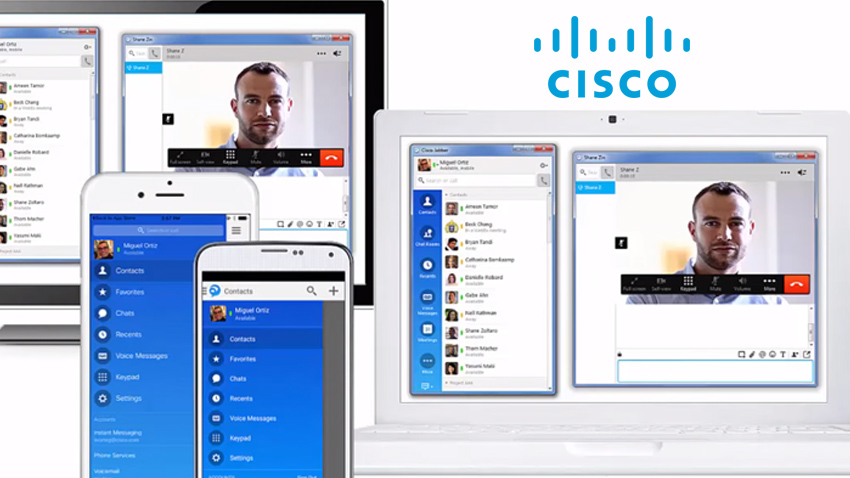The field of enterprise communications platforms is nothing if not intriguing. It seems the more you learn, the more questions there are to ask.
Questions like – when exactly does telephony cross the line into Unified Communications? Was there a point in history where everyone just started to use the latter in place of the former, or is there still a clear line of demarcation between the two which we can define?
And what about when collaboration is thrown into the mix – when does UC become UCC?
If you are going to ask these questions of anyone, you might as well ask them of Cisco. The Silicon Valley giant, the world’s largest networking company, has been right at the forefront of most of the innovations which have swept the telecoms market over the past three decades.
Having successfully ridden the waves of both the IP and, latterly, cloud revolutions, Cisco has been a dominant presence in both VoIP and hosted communications services, playing a significant role in promoting the spread of cloud-based enterprise UC through its virtualised Unified Computing System (UCS).
Cisco Jabber is a product which pulls all of these threads together. Marketed as a collaboration and UC software platform, it runs on the Cisco Unified Communications Manager – previously known as CallManager, and for all intents and purposes a software PBX server. Capable of being downloaded to be run on-premises in the data centre, Jabber can also be run as a private cloud solution in a virtualised environment, or as a hosted cloud service in the Cisco Collaboration Cloud.
VoIP, Unified Communications, collaboration, on-premises, private cloud and hosted? What do all of these definitions mean? Or, perhaps more pertinently, are they distinctions that matter anymore? We will attempt to unpick answers to those questions as we assess what Cisco Jabber can do.
As always, please remember that UC Today is a completely independent service which plays no role in the promotion or marketing of any brand or product. The opinions expressed in this review are those of the author only.
What Can It Do?
Cisco Jabber operates as a “single pane of glass” software interface for the Cisco Unified Communications Manager platform. It combines IP telephony, visual voicemail, voice, web conferencing, desktop sharing, contact history and integrated directories, with real-time availability and presence information plus easy, one-click communication with individuals and groups.
Jabber can be deployed either as an on-premises software option in a company’s own datacentre, virtualised in Citrix XenDesktop, XenApp or VMware Horizon View, as a private cloud, a third-party hosted service, a cloud service direct from Cisco partners, or as hybrid combinations of any of these.
As an IP telephony solution, Jabber operates as a softphone with integrated voice and video. It uses Unified Communications Manager’s session control, call management and failover protocols to provide reliable, robust, enterprise class telephony for up to 80,000 users. Desktop telephones from the Cisco Unified IP Phones 9900, 8900, 7900 and 6900 series are supported with CTI enabled.
The Jabber softphone also provides high definition video for point-to-point or conference calls with high fidelity wideband audio. As a standards based platform, video calls can be made to users of other video platforms. The system also supports a number of Cisco Telepresence endpoints.
As an alternative to standard telephony, users can subscribe to the Cisco WebEx Messenger service instead of the Unified Communications Manager, providing ‘Jabber-to-Jabber’ voice and video but no external communications support.
Group chat and audio conferencing are available at the click of a button, without the need to schedule or invite. Jabber delivers IM via the advanced XMPP protocol, providing flexible options for personal and group chat, plus chat room platforms. Chat history is stored so communications can be reviewed later, and chat is fully integrated with all other Jabber functions, so users can always send a quick IM no matter what they are doing.
WebEx conferencing can be launched directly from within Jabber, with full support for desktop, presentation and file sharing as well as video, audio and IM. Jabber also supports Cisco’s Collaboration Meeting Rooms Cloud.
Jabber is available as an application for Windows, Mac, iOS and Android, so there is equal distribution of features between desktop and mobile devices. Unlike other UC products where the mobile client offers a slimmed down suite of tools, Jabber for iOS and Android gives the whole shebang, turning your mobile into an IP softphone with fully integrated video, IM, conferencing and sharing capabilities.
What do we like?
As an all-in-one, single pane of glass UC and collaboration platform, Jabber is as comprehensive as they come. It isn’t just the quality and the range of the usual UC tools which impress, but the little touches, too – the ability to customise presence status to suit your business, the easy one-click escalation between media, so what starts as a simple IM can end in a full blown group conference session in just a few clicks.
The flexibility of the deployment options are also hugely impressive. On-premises, virtualised, private cloud, third party hosted, hosted by Cisco, hybrid – Cisco takes the idea of customer choice seriously, and has invested heavily in its own cloud provisions so it can offer products like Jabber any way the customer wants them.
Who is it for?
It is tempting to say Cisco Jabber is for the future-facing business, for the innovators and cavalier spirited who have done with traditional telephony. What is probably more accurate is to say Jabber is for those businesses which no longer view telephony as first amongst equals in the communications mix, which want a comprehensive blend of tools including VoIP all in one place. Scalable to enterprise levels, Jabber is not really for businesses of any particular size. Instead, it is for organisations which are looking for convergence, flexibility and simplicity in their communications solutions.
What is it compatible with?
Jabber comes with ready to go integration with Microsoft Outlook. As well as sharing the contacts directory, Jabber presence and click-to-communicate features are transferred into Outlook, so you can see who is online from your emails and click to make a call or IM. It shares presence information and IM with other XMPP-based systems, such as GoogleTalk and IBM Lotus Sametime. Also, the Jabber Software Development Kit (SDK) allows users to connect Jabber to their own web platforms, making its features available through the site.
Where to buy and for how much?
Pricing and purchasing details can be obtained by registering an account with Cisco, or alternatively contact your nearest Cisco partner or reseller.
UC Today Opinion
VoIP server, UC application, collaboration platform – which is Jabber? The honest answer is, all three, but that in itself is no longer unique in the world of business communications systems. Unified Communications is, by definition, the convergence of all available communications media into one, and these days, in different ways and to different extents, it is what everyone is doing.
What can be said about Jabber is, it is not a VoIP platform first and foremost. In the Jabber architecture, voice is just another tool, part of a greater whole. It is not, therefore, really a product for anyone looking for a telephony solution – the distinction, therefore, is perhaps in what the customer’s priorities are.
If your priorities are a flexible choice of deployment options, easy one-click navigation between communications tools, access to the powerful WebEx conferencing suite, easy collaboration, the ability to access the system wherever there is an internet connection – on those scores, Jabber as good as is available.
Do you use Cisco Jabber in your place of work? What are your thoughts about its strengths and weaknesses? Does it replace your telephone system or run alongside it? And what about Cisco partners and resellers, how does Jabber rate amongst your customers? Do you offer it as a hosted service? Please feel free to have your say in the comments section below, and as always, feel free to share this article on social media to invite others to join in the conversation.







